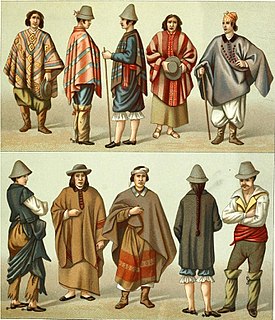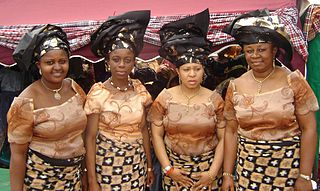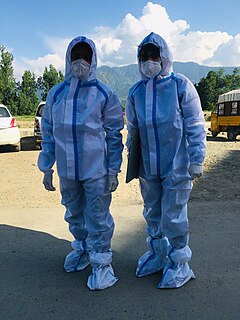
Oilcloth, also known as enameled cloth or American cloth, is close-woven cotton duck or linen cloth with a coating of boiled linseed oil to make it waterproof.

Oilcloth, also known as enameled cloth or American cloth, is close-woven cotton duck or linen cloth with a coating of boiled linseed oil to make it waterproof.
Boiled linseed oil was prepared by a long boiling of linseed oil with metal salts, originally lead dross. [1] The modern oil is less toxic, but also less suitable for making oilcloth. Re-enactors may boil their own oil in the search for a correctly coloured oilcloth. [1] [2] Oilcloth used for weatherproofing may have used a mixture of lead and manganese salts, the sienna and umber pigments, to give a more humidity-resistant cure. [1]
The fabric was first stretched on a tenter frame and sized with animal gelatine. The oil was then applied and allowed to cure between coats. As the cure relies on oxidation by the air, thin coats and long cure times between are required. [1] [2]
Overlaps between sheets of fresh oilcloth would amalgamate naturally when pressed together. This tendency also led to the cloth sticking together when folded. The cloth was waxed or dusted with pumice to reduce sticking when folding was required.
Seams in traditional oilcloth could be coated after sewing to reduce leakage through their stitching. This was generally unsatisfactory for clothing though and so overcoats of this era would incorporate one or more short capes over the shoulders. These capes were made in one piece and covered the inevitable shoulder seams in the main garment. These capes remain today in garments such as the Ulster and Inverness.
In the 19th century, waxed cotton and Mackintosh developed and began to gradually replace oilcloth, especially for clothing.[ citation needed ]
Historically, pre-19th century, oilcloth was one of very few flexible, waterproof materials that were widely available. Leather was expensive—very expensive in large pieces—and required regular maintenance if often wetted. Oilcloth was used as an outer waterproof layer for luggage, both wooden trunks [3] and flexible satchels, for carriages and for weatherproof clothing. [1]
The most familiar recent use was for brightly printed kitchen tablecloths. Dull-colored oilcloth was used for bedrolls, sou'westers, and tents. By the late 1950s, oilcloth became a synonym for vinyl (polyvinyl chloride) bonded to either a flanneled cloth or a printed vinyl with a synthetic non-woven backing.

Textile is an umbrella term that includes various fiber-based materials, including fibers, yarns, filaments, threads, different fabric types, etc. At first, the word "textiles" only referred to woven fabrics. However, weaving is not the only manufacturing method, and many other methods were later developed to form textile structures based on their intended use. Knitting and non-woven are other popular types of fabric manufacturing. In the contemporary world, textiles satisfy the material needs for versatile applications, from simple daily clothing to bulletproof jackets, spacesuits, and doctor's gowns.

Canvas is an extremely durable plain-woven fabric used for making sails, tents, marquees, backpacks, shelters, as a support for oil painting and for other items for which sturdiness is required, as well as in such fashion objects as handbags, electronic device cases, and shoes. It is also popularly used by artists as a painting surface, typically stretched across a wooden frame.

A raincoat is a waterproof or water-resistant garment worn on the upper body to shield the wearer from rain. The term rain jacket is sometimes used to refer to raincoats with long sleeves that are waist-length. A rain jacket may be combined with a pair of rain pants to make a rainsuit. Rain clothing may also be in one piece, like a boilersuit. Raincoats, like rain ponchos, offer the wearer hands-free protection from the rain and elements; unlike the umbrella.

A tarpaulin or tarp is a large sheet of strong, flexible, water-resistant or waterproof material, often cloth such as canvas or polyester coated with polyurethane, or made of plastics such as polyethylene. Tarpaulins often have reinforced grommets at the corners and along the sides to form attachment points for rope, allowing them to be tied down or suspended.

Linoleum, sometimes shortened to lino, is a floor covering made from materials such as solidified linseed oil (linoxyn), pine resin, ground cork dust, sawdust, and mineral fillers such as calcium carbonate, most commonly on a burlap or canvas backing. Pigments are often added to the materials to create the desired colour finish. Commercially, the material has been largely replaced by sheet vinyl flooring, although in the UK this is often still referred to as lino.

Gabardine is a tough, tightly woven fabric used to make suits, overcoats, trousers, uniforms, windbreakers and other garments.

A poncho is an outer garment designed to keep the body warm. A rain poncho is made from a watertight material designed to keep the body dry from the rain. Ponchos have been used by the Native American peoples of the Andes and Patagonia since pre-Hispanic times, from places now under the territory of Ecuador, Colombia, Chile, Bolivia, Peru, and Argentina and are now considered typical South American garments.
An oilskin is a waterproof garment, typically worn by sailors and by others in wet areas, such as fish-plant workers. The modern oilskin garment was developed by a New Zealander, Edward Le Roy, in 1898. Le Roy used worn-out sailcloth painted with a mixture of linseed oil and wax to produce a waterproof garment suitable to be worn on deck in foul-weather conditions. Oilskins are part of the range of protective clothing also known as foul weather gear.

The quechquemitl is a garment which has been worn by certain indigenous ethnicities in Mexico since the pre-Hispanic period. It usually consists of two pieces of rectangular cloth, often woven by hand, which is sewn together to form a poncho or shawl like garment, which is usually worn hanging off the shoulders. It can be constructed of various different fabrics, often with intricate weaves, and is typically highly decorated, most often with embroidery.

The wrapper, lappa, or pagne is a colorful garment widely worn in West Africa by both men and women. It has formal and informal versions and varies from simple draped clothing to fully tailored ensembles. The formality of the wrapper depends on the fabric used to create it.
The manufacture of textiles is one of the oldest of human technologies. To make textiles, the first requirement is a source of fiber from which a yarn can be made, primarily by spinning. The yarn is processed by knitting or weaving, which turns yarn into cloth. The machine used for weaving is the loom. For decoration, the process of colouring yarn or the finished material is dyeing. For more information of the various steps, see textile manufacturing.

The study of the history of clothing and textiles traces the development, use, and availability of clothing and textiles over human history. Clothing and textiles reflect the materials and technologies available in different civilizations at different times. The variety and distribution of clothing and textiles within a society reveal social customs and culture.
Ventile, is a registered trademark used to brand a special high-quality woven cotton fabric first developed by scientists at the Shirley Institute in Manchester, England. Originally created to overcome a shortage of flax used for fire hoses and water buckets, its properties were also found to be ideal for pilots' immersion suits.

In textile manufacturing, finishing refers to the processes that convert the woven or knitted cloth into a usable material and more specifically to any process performed after dyeing the yarn or fabric to improve the look, performance, or "hand" (feel) of the finish textile or clothing. The precise meaning depends on context.

Waxed cotton is cotton impregnated with a paraffin or natural beeswax based wax, woven into or applied to the cloth. Popular from the 1920s to the mid-1950s, the product, which developed from the sailing industry in England and Scotland, became commonly used for waterproofing. It has been replaced by more modern materials but is still used by the country sports community. The main drawbacks are two: waxed fabric is not very breathable and tends to be heavier and bulkier than modern synthetic waterproof materials.
Sewing is the craft of fastening or attaching objects using stitches made with needle and thread. Sewing is one of the oldest of the textile arts, arising in the Paleolithic Era. Although usually associated with clothing and household linens, sewing is used in a variety of crafts and industries, including shoemaking, upholstery, sailmaking, bookbinding and the manufacturing of some kinds of sporting goods. Sewing is the fundamental process underlying a variety of textile arts and crafts, including embroidery, tapestry, quilting, appliqué and patchwork.
A finishing oil is a vegetable oil used for wood finishing.
Wet process engineering is one of the major streams in textile engineering which refers to the engineering of textile chemical processes and associated applied science. The other three streams in textile engineering are yarn engineering, fabric engineering, and apparel engineering. The processes of this stream are involved or carried out in an aqueous stage. Hence, it is called a wet process which usually covers pre-treatment, dyeing, printing, and finishing.

A tanmono is a traditional Japanese narrow-loomed cloth. It is used to make traditional Japanese clothes, textile room dividers, sails, and other traditional cloth items.

Coated fabrics are those that have undergone a coating procedure to become more functional and hold the added properties, such as cotton fabrics becoming impermeable or waterproof. Coated textiles are used in a variety of applications, including blackout curtains and the development of waterproof fabrics for raincoats.